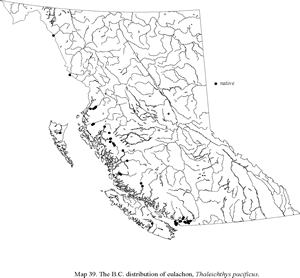Dorsal spines (total): 0; Dorsal soft rays (total): 10 - 13; Anal spines: 0; Anal soft rays: 18 - 23; Vertebrae: 65 - 72. Distinguished by the large canine teeth on the vomer and 18 to 23 rays in the anal fin (Ref. 27547). Adipose fin sickle-shaped; paired fins longer in males than in females; all fins with well developed breeding tubercles in ripe males which are poorly developed or absent in females (Ref. 27547). Adult coloration is brown to blue on back and top of the head, the sides lighter to silvery white, and the ventral surface white; speckling is fine, sparse and restricted to the back; peritoneum is light with black speckles (Ref. 6885). Fins transparent, pectorals and caudal often dusky (Ref. 27547). During spawning, male fish has a distinctly raised ridge along the middle of the body and a rough texture, differentiating it from the female which is smaller, smoother and shinier.
Introduction
|
Species Information
Biology
|
Distribution
|
BC Distribution and Notes Spawning runs of eulachon are known from most major rivers along the B.C. coast. This fish is especially significant to the coastal first nations and appears to be in serious decline in the Fraser River. Source: Information provided by Don McPhail for E-Fauna BC. Global Distribution North Pacific: west of Saint Matthew Island and Kuskokwim Bay in the Bering Sea, and Bowers Bank in the Aleutian Islands to Monterey Bay, California, USA. Populations from northern British Columbia are separate from those in the Fraser River (Ref. 10276). Source: FishBase. Eschmeyer, W.N., E.S. Herald and H. Hammann 1983 A field guide to Pacific coast fishes of North America. Houghton Mifflin Company, Boston, U.S.A. 336 p. |
Status Information
BC Ministry of Environment: BC Species and Ecosystems Explorer--the authoritative source for conservation information in British Columbia. |
